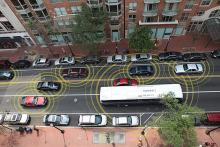Emerging technologies have the potential to significantly reduce vehicle crashes and associated fatalities, according to Kirk Steudle, director of the Michigan Department of Transportation, testifying at the US House Transportation and Infrastructure Committee, Subcommittee on Highways and Transit.
Speaking on behalf of the American Association of State Highway and Transportation Officials, Steudle said, "Nothing is more exciting than the potential safety benefits of this emerging technology," said Steud
Emerging technologies have the potential to significantly reduce vehicle crashes and associated fatalities, according to Kirk Steudle, director of the 1688 Michigan Department of Transportation, testifying at the US House Transportation and Infrastructure Committee, Subcommittee on Highways and Transit.
Speaking on behalf of the4944 American Association of State Highway and Transportation Officials, Steudle said, "Nothing is more exciting than the potential safety benefits of this emerging technology," said Steudle. "In 2011, 5.3 million vehicle crashes in the US resulted in 32,000 fatalities and more than 2.2 million injuries. The use of sensory and communications equipment to enable vehicles to speak to each other and the surrounding roadway infrastructure has the potential to significantly reduce the number of traffic crashes and save countless lives."
Steudle said that the goal is to build the safest and most efficient transportation system imaginable, by creating crash-free vehicles; vehicles that can drive themselves; and vehicles, drivers, and transportation infrastructure that safely, securely, and reliably share real-time information.
Speaking at the same meeting, Mike Robinson, GM’s vice president of sustainability and global regulatory affairs, said technology that could lead to autonomous vehicles is improving steadily, but drivers will remain integral to the operation of motor vehicles for many years to come, saying for the foreseeable future drivers will still need to be engaged and in control.
“For the most part, people assume than an autonomous vehicle will take you to your destination without any personal involvement,” said Robinson. “These types of driverless systems are a significant distance into the future.”
Ultimately, autonomous vehicles will navigate the road without human input, with electronic sensors and optical cameras reacting to well-defined lane and curb markers. Officials said vehicles could move more smoothly, the distance between vehicles kept constant, potentially resulting in a traffic system that is less congested and safer. It could also reduce fuel costs.
“This is technology that is going to be liberating,” said Robinson.
Earlier this year, the834 National Highway Traffic Safety Administration issued plans for research on autonomous vehicles, including proposals to look into connected vehicle technology that will allow self-driving cars to communicate via wireless radio signals, transmitting information on speed, lane departure and other data.
NHTSA head David Strickland said while his agency is looking closely at self-driving vehicle technology, a fully autonomous vehicle is “far off in the future.”
Valuable insight into the deployment of these advanced systems is being shaped by significant state DOT research programs underway in Arizona, California, Florida, Michigan, New York, and Virginia.
"This will be an evolutionary process," said Steudle. "It will require many years of additional research, development, and testing. Funding this major investment is critical because it will lead to an understanding of the breadth of possible operating scenarios and implications that autonomous and connected vehicle technology will have on society and on our transportation system as a whole. We need a coordinated effort to effectively prepare our nation for the SEA-change in the way surface transportation will function in the future," he said.
Speaking on behalf of the
Steudle said that the goal is to build the safest and most efficient transportation system imaginable, by creating crash-free vehicles; vehicles that can drive themselves; and vehicles, drivers, and transportation infrastructure that safely, securely, and reliably share real-time information.
Speaking at the same meeting, Mike Robinson, GM’s vice president of sustainability and global regulatory affairs, said technology that could lead to autonomous vehicles is improving steadily, but drivers will remain integral to the operation of motor vehicles for many years to come, saying for the foreseeable future drivers will still need to be engaged and in control.
“For the most part, people assume than an autonomous vehicle will take you to your destination without any personal involvement,” said Robinson. “These types of driverless systems are a significant distance into the future.”
Ultimately, autonomous vehicles will navigate the road without human input, with electronic sensors and optical cameras reacting to well-defined lane and curb markers. Officials said vehicles could move more smoothly, the distance between vehicles kept constant, potentially resulting in a traffic system that is less congested and safer. It could also reduce fuel costs.
“This is technology that is going to be liberating,” said Robinson.
Earlier this year, the
NHTSA head David Strickland said while his agency is looking closely at self-driving vehicle technology, a fully autonomous vehicle is “far off in the future.”
Valuable insight into the deployment of these advanced systems is being shaped by significant state DOT research programs underway in Arizona, California, Florida, Michigan, New York, and Virginia.
"This will be an evolutionary process," said Steudle. "It will require many years of additional research, development, and testing. Funding this major investment is critical because it will lead to an understanding of the breadth of possible operating scenarios and implications that autonomous and connected vehicle technology will have on society and on our transportation system as a whole. We need a coordinated effort to effectively prepare our nation for the SEA-change in the way surface transportation will function in the future," he said.








